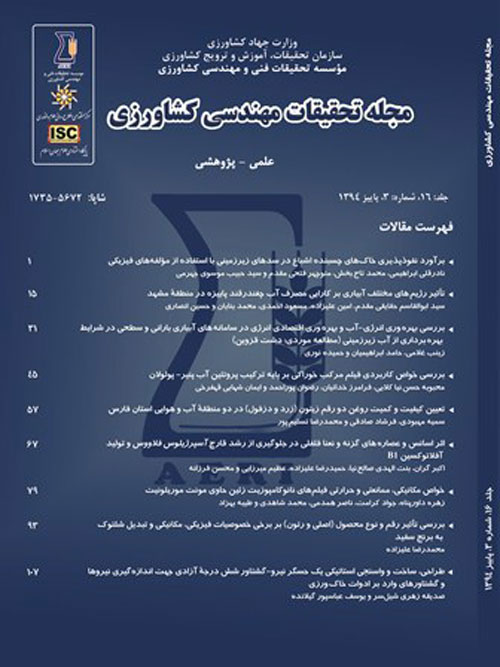Mechanized Dry Seeding Methods for Rice in Khuzestan
Author(s):
Abstract:
This study examined suitable mechanized methods to seed rice in dry-bed conditions using dried seeds and determined the most suitable varieties for each method. The experimental design was strip-plots in a randomized complete block design with two factors (seeding methods and rice varieties) and three replications. The testing took place during 2003-2004 at the Shavour Agricultural Research Station in Khuzestan province. The rice varieties were Anboury, Champa and Danial (horizontal factors) and theseeding methods were use of grain drill (Barzagar Hamadan), row planter (hill drop planter) and centrifugal broadcaster (vertical factors). The rice varieties were evaluated based on total yield, yield components and other agronomic characteristics. Seeding machines were evaluated and compared based on field capacity, fuel consumption, inter-row and intra-row seed spacing uniformity and seed germination. The analysis of variance for the two years showed that the grain yield was significantly affected by year, variety and their interaction. The average yield of the second year was significantly greater than that of the first year. A maximum yield of 7246 kg/h and minimum yield of 5667 kg/h were recorded for Danial (LD183) and Champa, respectively. There was no significant difference between the average yields of the different seeding methods in both years. Seeding methods also had no significant effect on the agronomic characteristics of the rice varieties except for the number of panicles per m2. In this case, the grain drill with329 and row planter with 289 panicles per m2 had the highest and lowest values, respectively. The evaluation of the seeding machines showed that there was a significant difference between the machines for all operational parameters. The centrifugal broadcaster had greater field capacity, low fuel consumption and better seed germination. In case of inter-row and intra-row seed spacing uniformity, the row planter had 68.8% inter-row uniformity and 89.7% intra-row uniformity, giving it the best seeding uniformity of the tested machines. Results indicate that the use of a row planter for dry seeding of rice is recommended because it used a less seed (20-25 kg/h) and had better seeding uniformity. However, considering farm conditions and available facilities, the centrifugal broadcaster and grain drill can be used for dry rice and direct seeding, respectively.
Keywords:
Language:
Persian
Published:
Journal of Agricultural Engineering Research, Volume:10 Issue: 1, 2010
Page:
81
https://magiran.com/p780356
دانلود و مطالعه متن این مقاله با یکی از روشهای زیر امکان پذیر است:
اشتراک شخصی
با عضویت و پرداخت آنلاین حق اشتراک یکساله به مبلغ 1,390,000ريال میتوانید 70 عنوان مطلب دانلود کنید!
اشتراک سازمانی
به کتابخانه دانشگاه یا محل کار خود پیشنهاد کنید تا اشتراک سازمانی این پایگاه را برای دسترسی نامحدود همه کاربران به متن مطالب تهیه نمایند!
توجه!
- حق عضویت دریافتی صرف حمایت از نشریات عضو و نگهداری، تکمیل و توسعه مگیران میشود.
- پرداخت حق اشتراک و دانلود مقالات اجازه بازنشر آن در سایر رسانههای چاپی و دیجیتال را به کاربر نمیدهد.
In order to view content subscription is required
Personal subscription
Subscribe magiran.com for 70 € euros via PayPal and download 70 articles during a year.
Organization subscription
Please contact us to subscribe your university or library for unlimited access!


